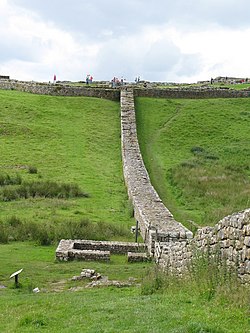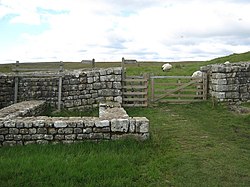Description
Knag Burn Gateway is one of the few gates through the wall that isn't part of a milecastle or fort. [1] The remains indicate that the structure consisted of a single-lane gateway, with guard-chambers on either side and a gate at each end, thus allowing two-stage controlled passage through the wall. [2] Professor I. A. Richmond suggested that the gateway was constructed to allow trade traffic through the wall some time in or after the fourth century. [3]
The gateway was discovered in 1855 and excavated in 1936 and 1988. The structure consists of the 3.7 metres (12 ft) wide gateway with two small structures either side. [4]
The two cell structures at either side of the gateway measure 4.65 metres (15.3 ft) by 3.25 metres (10.7 ft), with entrances 0.95 metres (3 ft 1 in) wide (on the side nearest the gateway), which open onto a passage. [4]
This page is based on this
Wikipedia article Text is available under the
CC BY-SA 4.0 license; additional terms may apply.
Images, videos and audio are available under their respective licenses.




